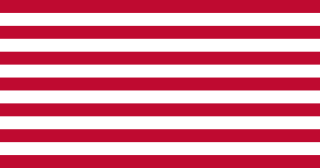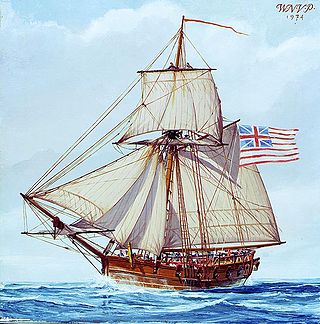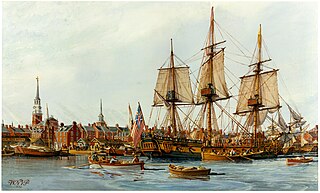
The Continental Navy was the navy of the Thirteen Colonies during the American Revolutionary War. Founded on October 13, 1775, the fleet developed into a relatively substantial force throughout the Revolutionary War, owing partially to the substantial efforts of the Continental Navy's patrons within the Continental Congress. These Congressional Patrons included the likes of John Adams, who served as the Chairman of the Naval Committee until 1776, when Commodore Esek Hopkins received instruction from the Continental Congress to assume command of the force.

Captain Silas Talbot was an American military officer and slave trader. He served in the Continental Army and Continental Navy during the American Revolutionary War, and is most famous for commanding USS Constitution from 1799 to 1801. Talbot was a member of the Society of the Cincinnati's branch in New York.

USS Providence was a sloop-of-war in the Continental Navy, originally chartered by the Rhode Island General Assembly as Katy. The ship took part in a number of campaigns during the first half of the American Revolutionary War before being destroyed by her own crew in 1779 to prevent her falling into the hands of the British after the failed Penobscot Expedition.

Alfred was the merchant vessel Black Prince, named for Edward, the Black Prince, and launched in 1774. The Continental Navy of what would become the United States Navy acquired her in 1775, renamed her Alfred after 9th century English monarch Alfred the Great, and commissioned her as a warship. She participated in two major actions, the battle of Nassau, and the action of 6 April 1776. The Royal Navy captured her in 1778, took her into service as HMS Alfred, and sold her in 1782. She then became the merchantman Alfred, and sailed between London and Jamaica.

A South Carolina Navy has been formed twice by the State of South Carolina. The first time was during the American Revolutionary War, in which the state purchased and outfitted armed vessels independent of the Continental Navy. The second time was during the American Civil War, when its navy was also distinct from the Confederate States Navy.

Samuel Tucker was an officer in the Continental Navy and the United States Navy.
The first USS Lee was a schooner under the Continental Army during the American Revolutionary War. She was named for General Charles Lee.

John Manley (c.1733–1793) was an officer in the Continental Navy and the United States Navy. Manley was appointed commodore of "George Washington's fleet."

The Pennsylvania Navy served as the naval force of Pennsylvania during the American Revolution and afterward, until the formation of the United States Navy. The navy's vessels served almost exclusively on the Delaware River, and were active in first defending the approaches to the city of Philadelphia during the British campaign that successfully occupied the city in 1777, and then preventing the Royal Navy from resupplying the occupying army.

The Raid of Nassau was a naval operation and amphibious assault by American forces against the British port of Nassau, Bahamas, during the American Revolutionary War. The raid, designed to resolve the issue of gunpowder shortages, resulted in the seizure of two forts and large quantities of military supplies before the raiders drew back to New England, where they fought an unsuccessful engagement with a British frigate.
The 14th Continental Regiment, also known as the Marblehead Regiment and Glover's Regiment, was raised as a Massachusetts militia regiment in 1775, and taken into the Continental Army establishment during the summer of 1775. When the Continental Army was reestablished for 1776, the regiment was redesignated the 14th Continental. Composed of seafaring men from the area around Marblehead, Massachusetts, it manned the boats during the New York and New Jersey campaign of 1776 and the crossing of the Delaware River before and after the Battle of Trenton. The men of the regiment were only enlisted for one and a half years, and the regiment was disbanded on December 31, 1776, in eastern Pennsylvania.

The history of the United States Marine Corps (USMC) begins with the founding of the Continental Marines on 10 November 1775 to conduct ship-to-ship fighting, provide shipboard security and discipline enforcement, and assist in landing forces. Its mission evolved with changing military doctrine and foreign policy of the United States. Owing to the availability of Marine forces at sea, the United States Marine Corps has served in nearly every conflict in United States history. It attained prominence when its theories and practice of amphibious warfare proved prescient, and ultimately formed a cornerstone of U.S. strategy in the Pacific Theater of World War II. By the early 20th century, the Marine Corps would become one of the dominant theorists and practitioners of amphibious warfare. Its ability to rapidly respond on short notice to expeditionary crises has made and continues to make it an important tool for U.S. foreign policy.

The schooner Hannah was the first armed American naval vessel of the American Revolution, authorized by the Continental Congress and operated by the Continental Army, and is considered by some the first vessel of the United States Navy. She was a fishing schooner owned by John Glover of Marblehead, Massachusetts and was named for his daughter, Hannah Glover. The crew was drawn largely from the town of Marblehead, with much of the ships ammunition being stored in Glover's warehouse now located at Glover's Square in Marblehead before being relocated to Beverly, Massachusetts.

The Massachusetts Naval Militia, was a naval militia active during the American Revolutionary War. It was founded December 29, 1775, to defend the interests of Massachusetts during the war.
USS Washington was a schooner acquired by the Continental Navy during the American Revolution and converted to an armed brigantine. She served for only a short period of time before being captured by the British.
USS Spitfire was a row galley authorized and constructed by Rhode Island during the American Revolution, and was placed in service in 1776 in the Rhode Island Navy. During this age of sail, row galleys were highly maneuverable compared to sailing ships whose movements were dependent on the wind. Spitfire had a reportedly successful career, helping to capture British cargo ships and engaging in the fight against British warships.

The Connecticut State Navy was the colonial navy of Connecticut during the American Revolutionary War. Established in 1775, all of its ships were destroyed or captured by 1779. In the remaining years of the war a few smaller ships were commissioned to interdict smuggling between the Connecticut shore and Tory-controlled Long Island.

The Rhode Island State Navy was the first colonial or state navy established after the American Revolutionary War began in April 1775 with the Battles of Lexington and Concord. On the following June 15, the General Assembly authorized the acquisition of two ships for the purpose of defending the colony's trade. The state's ships were generally used for defensive operations within Narragansett Bay, although some prizes were taken. The state was also one of the first to authorize privateering.

During the American Revolutionary War, the Georgia State Navy consisted of only a few ships, most of which were destroyed in 1778 and 1779.

Captain Nicholson Broughton (1724-1798) of Marblehead, Massachusetts was the first commodore of the American Navy and, as part of the Marblehead Regiment, commanded George Washington’s first naval vessel USS Hannah. Broughton set sail from Beverly, Massachusetts on 5 September 1775 in Hannah. He also led the first American expedition of the war, which went to interrupt shipping British armaments off Nova Scotia. On the expedition, Broughton participated in the Raid on Charlottetown. As a result of Broughton's expedition to Nova Scotia, the Governor of Nova Scotia Francis Legge declared martial law throughout the colony.












